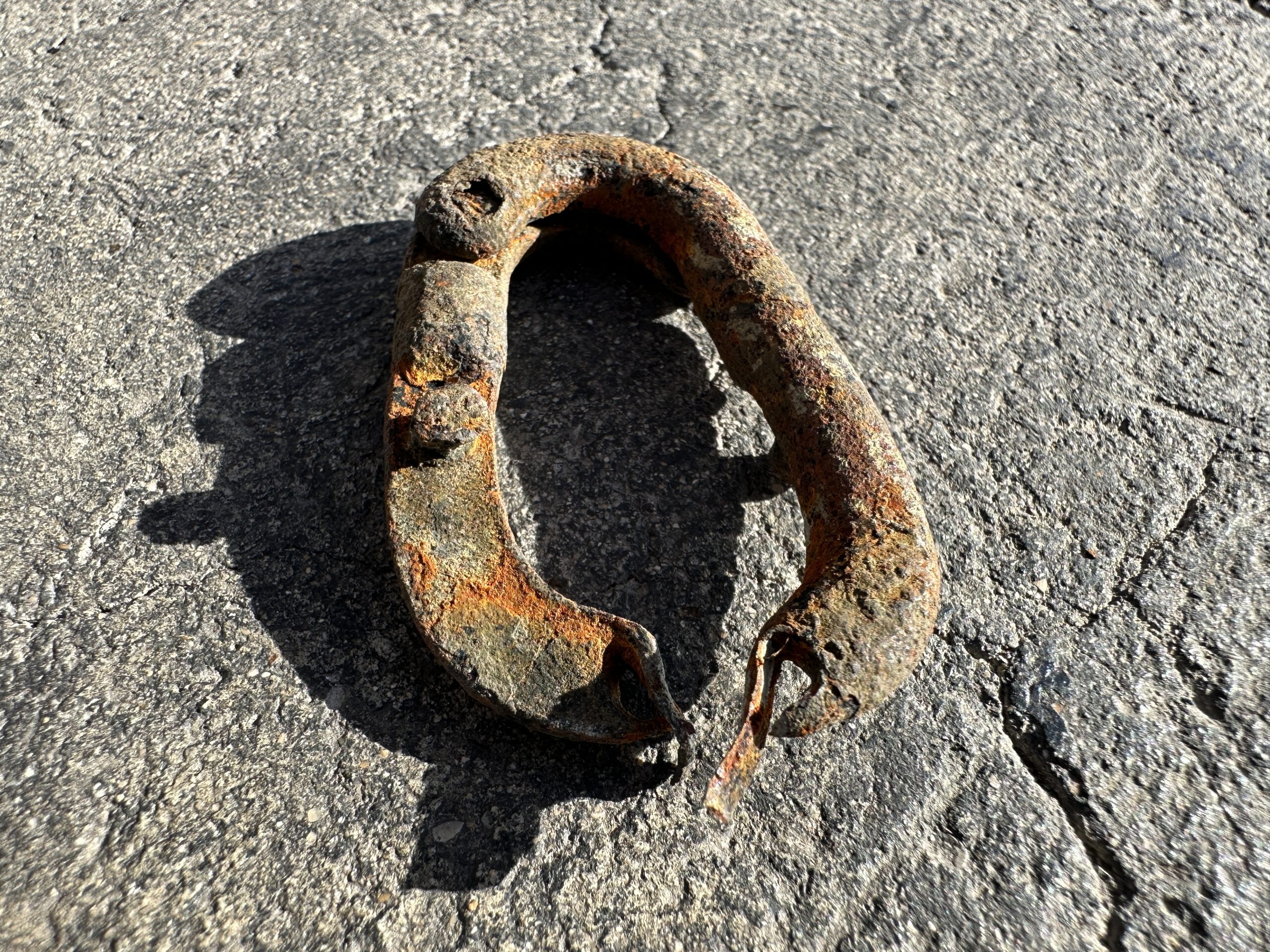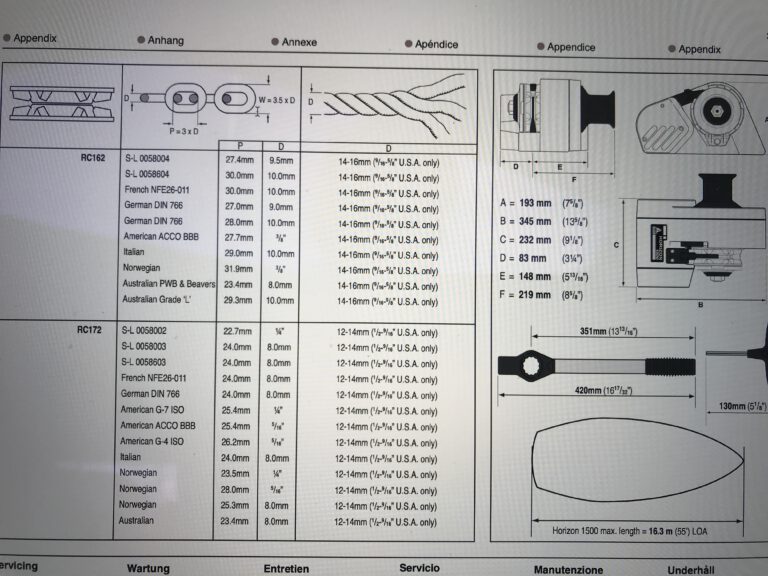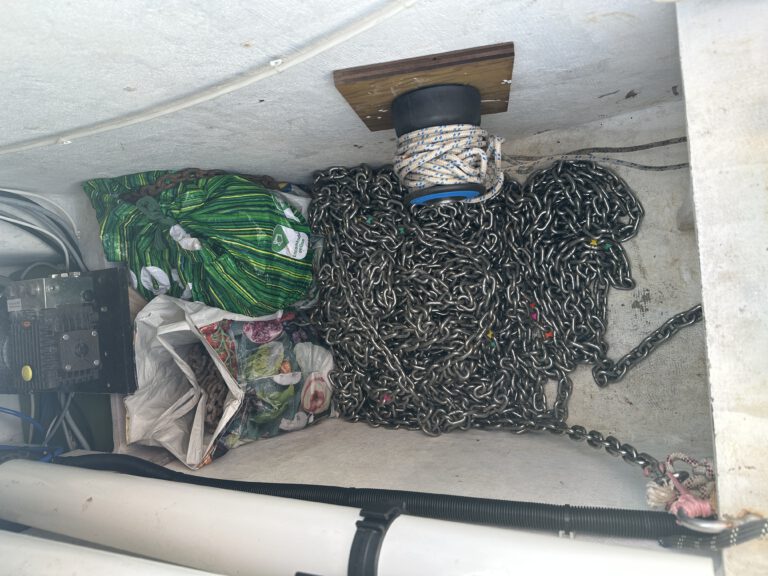What we would never have thought possible: The new chain breaks!
We live and work on board as long-term sailors, depending on the season and sailing area, we spend about half the time at anchor – so a good anchor harness is vital!
W: Shipyard times with the ship ashore
10%
H: Port times with the ship in port
20%
A: At anchor
50%
S: Sailing underway
20%
When we leave the ship, we put it into a safe harbour, at anchor there is always an anchor watch on board. We leave the anchored ship at most once in calm conditions for a short trip, as many imponderables can arise in the anchorage field:
- Shifting winds or capsizing tides can break out the anchor, which may not dig back in.
- The anchor may slip in strong winds or changing tides.
- Other anchors may come too close to the vessel.
- Sometimes the anchor is accidentally pulled by others.
We have experienced all this and were always glad to be on board and able to react to it.
Attack of the “mountain marine”: Austrians on a fishing charter boat fish our anchor
Since we started sailing the catamaran, we have continuously improved the anchor gear:
- Since we started sailing the catamaran, we have continuously improved the anchor gear:
- We use a welded Delta anchor of 50 lbs. as the main anchor with a new stainless steel anchor bracket, as the old aluminium guide was too weak and the anchor kept getting stuck in it.
- A forged CQR anchor of 40 lbs. as a second anchor, which is rigged ready for use on a bracket on the front beam.
- And a folding anchor of 20 lbs. as a coffee anchor.
- The anchor winch has been fitted with an additional remote control to make it easier to lower and tighten the chain.
- The galvanised 8mm anchor chain was 45m long and we found it was a little short for the steep conditions in the Canaries.
In the Canary Islands we decided to buy a new 60m anchor chain in January 2023:
In Tenerife at Marina Amarilla, we ordered a new chain according to DIN 766 made of 8 mm hot-dip galvanised steel from a specialist shop for a good price of €760. Then a galvanised chain was delivered that did not meet the required standard at all and did not fit into the guides of the windlass. We returned it and the right chain was ordered again.
It then turned out that the chain ordered was not available, only a better hot-dip galvanised quality at a surcharge of another 150€, which we accepted.
The suitable chain was finally delivered and installed after 4 weeks. We were very happy about the new shiny equipment and sailed two laps around the Canary Islands for 6 months.
Unbelievable: Emergency near Lanzarote alone at anchor:
The skipper had already changed the anchorage twice near the Museo Atlantico at Marina Rubicon in order to have enough leeward space even in a southerly wind. In order to be able to sleep peacefully, he had anchored 55 metres the night before in 12m water depth, almost the full length of the chain.
At 8:30 in the morning at breakfast: the chain jerked as usual in rhythm with the waves, not unusual in 10-15 knots of wind and 0.5 m swell. Then I felt a stronger jolt from the swell of the passing tourist boats and ferries – after that it was suddenly wonderfully calm.
Bernhard: “I was still unsure what to make of it, when 30 seconds later the anchor alarm went off. In disbelief, I looked at the plotter, which showed me that I was drifting at 3 knots. I immediately went out to see what was going on. The anchor chain was hanging vertically down and the ship was drifting across the wind. I threw off the capstan and picked up the anchor. After about 5 metres the chain disappeared into the anchor fitting… with no anchor!”
According to our quick-start protocol, it was possible to get the ship under control again with both engines, even with the rudders recovered – after 2 minutes, both engines were running and the loss of the ship and worse could be prevented.
2 h later In the harbour it became completely clear: anchor chain breakage! The anchor and 50m of chain had been lost in 12m of water and the ship was almost stranded on the rocky coast. Two days later we organised the recovery of the lost chain and anchor with two divers. We even found the broken chain connector.
What had happened???
We had not been sold 60m of chain in one piece, but 50m of dip-galvanised chain and 10m of hot-dip galvanised chain, which had been welded together with a cheap, galvanised and non-welded emergency chain connector. The chain had a breaking load of 63 kN, while the chain connector had a working load of only 0.3 kN and a breaking load of 1.26 kN. The inferior material also corroded very quickly!
Moreover, after 6 months on board and three weeks of use, the 50-metre section was completely rusted, the 10-metre section showed little zinc and the chain lock was rusted, thinned and then broken.
The complaint was for fraud and deliberate endangerment:
The supplier had gone out of business in the meantime and had gone into hiding. He did not respond to our complaint for weeks. We found his new company at another location in Las Chafiras. After 5 weeks he contacted us and denied any responsibility, saying that the guarantee had expired after 6 months and that we had not maintained the chain properly. He was not interested in the fact that an inferior chain was delivered in two different qualities with an even inferior chain connector.
Our next steps:
To be able to anchor again and continue, we reinstalled the broken and rusty chain to within 50m, but had a very bad feeling about it. So we took the following steps:
- Purchase and installation of a high-quality, seawater-resistant 70m long and 8mm thick stainless steel chain according to DIN 766.
- Complaint again with the help of a friendly dealer on Tenerife.
- Report for endangerment and attempted manslaughter to the Policia National
- Warning to all readers and friends of our blog
- Publicise in the sailing community ARC, TO, private contacts
In my 50 years as a diver and sailor, I have never heard of anyone breaking an anchor chain. I would have gladly done without that experience.
What saved us and our boat:
- 3 minutes offshore /from Legerwall.
- Anchor alarm from Time Zero
- A practised procedure for emergency starting of the engines
- Just offshore wind direction



















